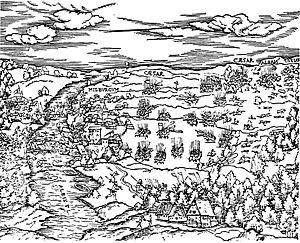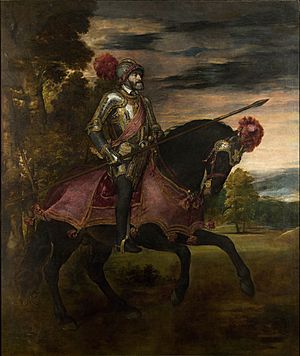Battle of Mühlberg facts for kids
Quick facts for kids Battle of Mühlberg |
|||||||
|---|---|---|---|---|---|---|---|
| Part of the Schmalkaldic War | |||||||
 The Battle of Mühlberg by Luis de Ávila y Zúñiga (1550) |
|||||||
|
|||||||
| Belligerents | |||||||
|
|
||||||
| Commanders and leaders | |||||||
| Strength | |||||||
| 6,000 infantry and 3,000 cavalry (15 guns) | 13,000 infantry and 4,500 cavalry (20 guns) | ||||||
| Casualties and losses | |||||||
| 8000 dead 500 knights 1,000 prisoners |
around 50 dead or wounded | ||||||
The Battle of Mühlberg was a major battle that happened in 1547 near Mühlberg in Germany. It was a key part of the Schmalkaldic War. In this battle, the forces of Holy Roman Emperor Charles V won a big victory. They defeated the Schmalkaldic League, which was an alliance of Protestant princes.
This battle was a turning point. It ended the Schmalkaldic War and led to the end of the Schmalkaldic League.
Contents
Why Did the Battle of Mühlberg Happen?
The Rise of the Protestant Reformation
After 1517, the Protestant Reformation spread quickly in Germany. This was a big challenge for Emperor Charles V. He wanted to keep everyone in his Holy Roman Empire united under the Catholic Church.
However, many German states saw the Reformation as a chance to gain more independence. They wanted to be free from the Emperor's control, not just in religion but also in politics. The Holy Roman Empire was already a loose collection of states, so many rulers felt they didn't owe much to the Emperor.
Formation of the Schmalkaldic League
In 1531, some powerful princes, like Philip I of Hesse and John Frederick of Saxony, disagreed with Emperor Charles V. They didn't want him to force religious and political unity on Germany.
Because of this, they formed the Schmalkaldic League. This was a military alliance named after the town of Schmalkalden. It was created to defend Protestant ideas and oppose the Emperor's Catholic rule.
Emperor Charles V's Strategy
At first, Charles V didn't attack the Schmalkaldic League. He needed the support of the German states for his wars against the Ottoman Turks. So, he allowed the League to have some freedom. This meant Protestant leaders could support the Reformation and challenge the power of Catholic bishops in their lands.
The League also got support from several free cities like Bremen and Lübeck. They also wanted more independence. Even the Kingdom of France, a main enemy of Charles V, supported the Protestant princes.
Changes Leading to Conflict
Things changed a few years later. In 1544, Charles V signed the Treaty of Crépy with Francis I of France. This ended a long conflict over Italy. After this, the Schmalkaldic League lost France's support.
Also, Martin Luther, a key figure in the Reformation, died in 1546. The threat from the Ottoman Turks also lessened. These events gave Charles V the perfect chance to deal with the Protestant princes who were challenging his power.
The Saxon Rivalry
The conflict began because of a rivalry between John Frederick I, the Elector of Saxony, and his cousin Maurice. Both were part of the House of Wettin. Even though Maurice was Protestant, he didn't join the Schmalkaldic League.
In 1546, Maurice, with help from Charles V's brother Ferdinand I, invaded John Frederick's land. John Frederick's armies were far away, but they quickly returned and pushed Maurice's forces back.
The Emperor saw this as an opportunity. He joined the war in 1547. He quickly defeated other Protestant rulers, forcing them to leave the League. Then, Charles V marched towards Saxony to help Maurice and defeat John Frederick, who was the last major Protestant prince still fighting him.
The Battle of Mühlberg: How it Happened

Emperor Charles V was suffering from gout (a painful joint condition) at the time. Also, some of his soldiers, who were from the Pope's army, left him. John Frederick's army was even larger than Charles's forces.
However, John Frederick made a risky choice. He hoped to start a Protestant uprising in Bohemia, so he sent a large part of his army there. He also left small groups of soldiers to protect Saxon cities from the south.
John Frederick then marched north towards the strong fortress of Wittenberg. He camped near Mühlberg, leaving only a few guards by the Elbe river. He thought the river was too wide for the Emperor's army to cross easily.
The Surprise Crossing
On the evening of April 23, Charles V's army reached the Elbe. Despite his generals' doubts, Charles decided to attack the enemy, who were just a few miles away.
At dawn on April 24, the first groups of imperial soldiers moved forward. They were looking for a way to cross the river. Helped by surprise and a thick fog, small groups of experienced Spanish and Italian soldiers swam across. They quickly defeated the few Saxon guards on the other side.
Meanwhile, some of Charles's most skilled soldiers, from the tercios of Lombardy and Naples, found a shallow spot (a ford) to cross the Elbe. This allowed the whole army to get across. They also stopped the Saxons from destroying a pontoon bridge they had built. This bridge was then used by the imperial cavalry to cross safely.
The Saxon Surprise
Some stories say that John Frederick thought an attack from Charles was so unlikely that he sent his commanders to Mass (church service) just as the Emperor's army was crossing the river. The Saxon forces were completely surprised.
When John Frederick realized what was happening, his first thought was to retreat to Wittenberg. But he soon saw that his army was too slow to move quickly. He also believed that only a small part of the Emperor's army was attacking. So, he ordered his troops to prepare for battle.
John Frederick placed his soldiers along the edge of a forest. This was to prevent the imperial cavalry from surrounding them and to have a safe escape route if they needed to retreat. Emperor Charles V also arrived on the battlefield. He encouraged his troops to fight the Protestants. Because of his gout, he was carried in a litter, not on a horse, and watched the battle from the back. The imperial army had about 16,000 to 20,000 men.
The Imperial Victory
The battle began in the evening. The Saxon army, mostly made up of peasants, managed to push back the first attacks from the Hungarian cavalry. However, Charles's soldiers were more numerous and better trained. They were among the best in the world at that time, and this decided the battle's outcome.
The Emperor had placed his cavalry on both sides of his army. The right side, led by the Duke of Alba, was stronger. The left side was led by Maurice of Saxony. Once the weaker Saxon army sides were defeated, the infantry tercios in the center easily broke through the enemy's defense. This forced the Protestants to retreat into the nearby forest.
John Frederick, the Elector of Saxony, fought bravely. But he was wounded in the face and captured by the imperial troops. Most of his soldiers were chased, killed, or captured.
Some accounts say that Emperor Charles V commented on his victory by saying, Vine, vi y venció Dios (in Spanish, "I came, I saw, and God won"). This was similar to a famous saying by Julius Caesar.
What Happened After the Battle?
The Battle of Mühlberg was a complete defeat for the Saxon army. They lost around 2,000 to 3,000 men. They also lost almost all their cannons, ammunition, and flags. Many soldiers were taken prisoner. On the Emperor's side, only about 50 soldiers were killed or wounded.
John Frederick was blamed for not preparing a strong defense at the Elbe river. This mistake allowed the imperial troops to cross easily. His capture meant the end of the Schmalkaldic League.
Charles V decided to spare John Frederick's life. But in exchange, John Frederick had to surrender the fortress of Wittenberg (Capitulation of Wittenberg). He was declared a heretic and put in prison. He also had to give his title as Elector of Saxony to his cousin Maurice. Maurice had helped the Emperor win the battle. John Frederick was later released in 1552, two years before he died.
Soon after, Philip of Hesse also surrendered. This officially ended the Schmalkaldic War. However, the problem of Protestantism in Germany was not fully solved. Many Protestant leaders, like Martin Bucer, fled to England. They influenced the English Reformation there.
The peace agreement between Catholics and Protestants in Germany (Augsburg Interim, 1548) was not enough to bring lasting peace. It was only in 1555 that the Peace of Augsburg finally ended the religious wars in the Empire. This agreement allowed each ruler to choose between Catholicism and Lutheranism for their territory. This meant that the dream of uniting Germany under one religion was over.
Today, the town of Mühlberg has a small museum dedicated to this important battle.
See also
 In Spanish: Batalla de Mühlberg para niños
In Spanish: Batalla de Mühlberg para niños
- Charles V, Holy Roman Emperor
- Spanish Empire
- Electorate of Saxony
- Schmalkaldic League
- Equestrian Portrait of Charles V


